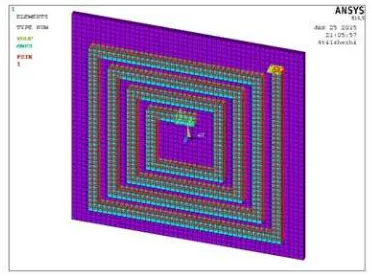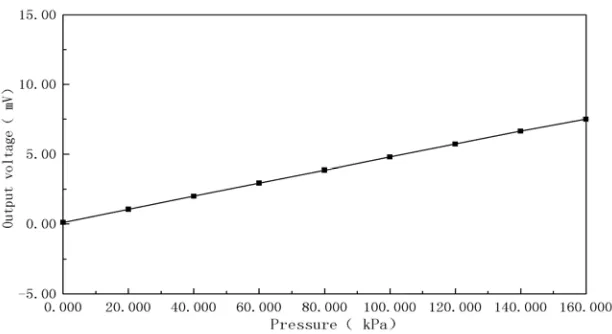DOI: 10.12928/TELKOMNIKA.v13i4.1740 1121
Research on Electromagnetic Excitation Resonant
Sensor Based on Microelectromechanical System
Gang Li1, Xiaofeng Zhao2, Dianzhong Wen*3, Yang Yu4
Key Laboratory of Electronics Engineering, College of Heilongjiang Province, Heilongjiang University No.74 of Xufu Road, Nangang district, Haerbin, Heilongjiang Province, China, +86-451-86609073
*Corresponding author, e-mail: [email protected], [email protected], [email protected], [email protected]
Abstract
In this paper, an electromagnetic excitation resonant sensor was designed based on Microelectromechanical system (MEMS) technology. In this new sensor, four nc-Si/c-Si heterojunction p-MOSFETs are manufactured by using the technique of MEMS on the N-type <100> orientation high resistance silicon wafer, and a Wheatstone bridge is composed of four nc-Si/c-Si heterojunction MOSFETs channel resistances, output voltage of the bridge circuit changes according to the applied pressure. A vibration will be generated when an alternating current is applied to the inductance coil of electromagnetic excitation resonant sensor, the maximum power produced in the central part of the four edges of silicon membrane, whose frequency and amplitude are associated with the current in the inductance coil, and the applied pressure P can be detected. Using mechanics and electromagnetism coupling field analysis by Ansys software, the simulation to vibration situation of the silicon membrane of sensor was carried on when vertical magnetic field and alternating current were loaded. Experimental results show that, as the operating voltage is constant, with the increase of current in the inductance coil the conversion of applied pressure increases, and the output voltage of nc-Si/c-Si heterojunction MOSFETs pressure sensor is proportional to the increase of coil magnetic field i.e. the increase of pressure, the experimental results are consistent with the simulation results.
Keywords: Electromagnetic Excitation Resonant Sensor; MEMS; Ansys; nc-Si/c-Si heterojunction MOSFET
Copyright © 2015 Universitas Ahmad Dahlan. All rights reserved.
1. Introduction
Electromagnetic excitation resonant sensor based on MEMS technology has become one of the hotspots of Microelectromechanical system (MEMS) research for its small size, light weight, compact structure, fast temperature response, impact durability, easiness of integration and mass production [1-5]. The sensor can be used in the manufacture of silicon micro-pump components, having broad application prospects in MEMS micro-flow devices and medical scientific research [6].
At present, cantilever beam structure is adopted in most of electromagnetic excitation resonant sensor, but its sensitivity to magnetic field is not high [7-13], and the manufacturing process is relatively complicated. In this paper, the sensor is manufactured by a new method that the planar spiral inductor coil is placed in the center of a pressure sensor which is composed of four nc-Si/c-Si heterojunction p-MOSFETs. The method is simple and has high sensitivity to magnetic field, and the integrated circuit can meet the requirement of high integration and low cost.
2. The Electromagnetic Excitation Resonant Sensor Structure
Figure 1 is cross-section of the electromagnetic excitation resonant sensor. Its silicon cup is manufactured by <100> orientation of monocrystalline silicon chip, which is N-type with high resistance and double-sided polishing. On the center of surface of silicon cup, we made an inductance coil adopting the method of an internal down-lead produced by ohm contact electrode which is constructed by heavily boron-diffused and the Al evaporated, and a Wheatstone bridge which is composed of four nc-Si/c-Si heterojunction MOSFETs channel resistances is used to detect the vibration of silicon membrane. Magnetic materials are fixed on the pedestal, which is made of insulating materials, and the inductance coil is right above the magnetic materials. Figure 2 shows the layout of the electromagnetic excitation resonant sensor chip.
An alternating magnetic field will be generated when an alternating current is applied to the inductance coil. The magnetic force produced by the interaction with the fixed magnetic field which was produced by magnetic materials causes the silicon membrane to vibrate.
Figure 1. The cross-section of the electromagnetic
excitation resonant sensor Figure 2. The layout of the electromagnetic excitation resonant sensor chip
3. Ansys Modeling Process
The components structure is complex, therefore, some simplifications were adopted when the finite element model was established, only inductance coil and silicon membrane model was built, as shown in Figure 3. The element type of inductance coil is “solid 236”, material model is aluminum, and cross sectional area is 100μm×100μm. The element type of silicon membrane is “solid 185”. “Sweep” was adopted to mesh inductance coil and silicon membrane respectively.
Figure 3. The picture of inductance coil and silicon membrane
Choose “analysis type” for “harmonic”, load alternating current of 10 + 10i mA on the middle end of inductance coil, at the frequency of 50 Hz, provide voltage=0 on the other end. Fix all sides of silicon membrane, apply perpendicular magnetic field and set the Z=0 surface energy exchange interface as coupling field, as shown in Figure 4 after setting.
4. The Results of Simulation
The solving order is from magnetic field to force field. We set the force pass from inductance coil to silicon membrane, and the displacement pass from silicon membrane to inductance coil, all objects of convergence to 1e-7, the analysis type of electromagnetic field is “harmonic”, and the analysis type of force field is “static”. The simulation results showed that the inductance coil can generate magnetic field, the vector diagram of inductance coil current density are as shown in Figure 5, the vector diagram of inductance coil magnetic field intensity are as shown in Figure 6.
Figure 5. The vector diagram of current density vector of inductance coil
Figure 6. The vector diagram of magnetic field intensity of inductance coil
After the solution, by observing the stress distribution of silicon membrane, as shown in Figure 7, the largest stress was found in the central part of the four edges of silicon membrane, larger output voltage may be obtained if four nc-Si/c-Si heterojunction MOSFETs channel resistances were placed in these positions. And in the process of simulation, the silicon membrane deformation was observed, certifying that the silicon membrane of sensor can produce vibration under alternating current excitation, and confirming the sensor design of originally envisioned is reasonable, the deformation situation is shown in Figure 8.
Figure 7. The simulation diagram of the stress distribution of silicon membrane
5. The Experimental Results
Figure 9 is the sample of the electromagnetic excitation resonant sensor. The structure picture of nc-Si/c-Si heterojunction MOSFET channel resistance which are placed in the central part of the four edges of silicon membrane is shown in Figure 10.
Figure 9. The sample of the electromagnetic excitation resonant sensor
Figure 10. The structure picture of nc-Si/c-Si heterojunction MOSFET channel resistance
Figure 10 shows the basic structure of p-MOSFET device with nc-Si/c-Si heterojunction as source (S) and drain (D), the thickness of silicon membrane is 56 nm, the channel aspect ratio is 2:1. Testing IDS-VDS characteristics of the nc-Si/c-Si heterojunction p-MOSFET by using
HP4145B semiconductor parameter analyzer, and the results are shown in Figure 11.
Figure 11. IDS-VDS characteristics of the nc-Si/c-Si heterojunction p-MOSFET
Figure 12 shows the input-output characteristics experimental curves of MOSFETs pressure sensor under the working voltage VDD = 1.5 V.
20
-7V -8V
-6V
0V
-5.0V
-4V
-3.0V
-2V -1V
x
y
Figure 12. Input-output characteristics experimental curves of MOSFETs pressure sensor.
Experimental results show that, as the operating voltage is constant, with the increase of current in the inductance coil the conversion of applied pressure increases, and the output voltage of nc-Si/c-Si heterojunction MOSFETs pressure sensor is proportional to the increase of coil magnetic field i.e. the increase of pressure, the experimental results are consistent with the simulation results.
6. Conclusion
The design of electromagnetic excitation resonant sensor, the simulation analysis and experimental testing results are given in this paper. A Wheatstone bridge which is composed of four nc-Si/c-Si heterojunction MOSFETs channel resistances is manufactured by using the technique of MEMS on the N-type <100> orientation high resistance silicon wafer, and this is a new structure of pressure sensor based on MOSFET. The input-output characteristics experimental curves of MOSFETs pressure sensor is given in this paper, which can be seen that the sensor has a good linearity when VDD is 1.5 V. An Al inductance coil is made on the
central part of surface of silicon membrane. The interaction of a magnetic field generated by current in inductance coil with the fixed magnetic field causes the silicon membrane to vibrate, and frequency and amplitude are associated with the applied altering current. With the increase of current in the inductance coil the conversion of applied pressure increases, and the output voltage of Wheatstone bridge increases with the increase of applied pressure, to detect the vibration of silicon membrane. The results of experiment and simulation have proved that our design scheme is feasible.
References
[1] Zhao Xiaofeng, Wen Dianzhong, Li Gang. Fabrication and characteristics of the nc-Si/c-Si heterojunction MOSFETs pressure sensor. Sensors. 2012; 12(5): 6369-6379.
[2] Zhao Xiaofeng, Wen Dianzhong, Zhuang Cuicui, et.al. Fabrication and Characteristics of the Magnetic Field Sensors Based on Nano-Polysilicon Thin-Film Transistors. Journal of Semiconductors. 2013; 34(3): 036001(1-6).
[3] Wen Dianzhong. Sensitivity Analysis of Junction Field Effect-Pressure Halltron. Review of Scientific Instrument. 1995; 66 (1): 251-255.
[4] Gradolph, Friedberger, Muller, et.al.environments on piezoresistive pressure sensor Impact of high-g and high vibration performance. Sensors and Actuators. A, Physical. 2009; 150(1): 69-77.
[5] Yoon JB, Choi YS, Kim B, et.al. CMOS Compatible Surface-Micromachined Suspended-Spiral Inductors for Multi-GHz Silicon RFICs. IEEE Electron Device Letters. 2002; 23(10): 591-593.
[6] Kinnell PK, Craddock R. Advances in silicon resonant pressure transducers. Procedia Chemistry. 2009; 1(1): 104-107.
[8] Mengran Liu, Guojun Zhang, Zeming Jian et.al. Design of Array MEMS Vector Vibration Sensor in the Location of Pipeline Internal Inspector. TELKOMNIKA Indonesian Journa of Electrical Engineering. 2014; 12(9): 6651- 6657.
[9] Zhang Zhi-yong, Hai Chao-he. High Q-Factor On-chip Spiral Inductors for Bulk Silicon CMOS RF IC’S. Microelectronics. 2003; 33(1): 15-18.
[10] Xiong Jijun, Yang Fang, Liang Ting, et.al. Influence of Q-Factor on Signal Transmission Performance of Passive Pressure Sensor. Nanotechnology and Precision Engineering. 2012; 10(5): 429–433. [11] Achmad Widodo, Latief Rozaqi, Ismoyo Haryanto, et.al. Development of Wireless Smart Sensor for
Structure and Machine Monitoring. TELKOMNIKA Telecommunication Computing Electronics and Control. 2013; 11(2): 417-424.
[12] Peng Guanbin, Liu Jingquan, Wand Longfei, et.al. Circuit Design of an Implantable MEMS Pressure Sensor System. Nanotechnology and Precision Engineering. 2013; 11(1): 90–95.



